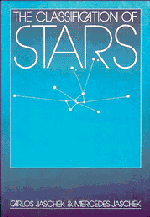10 - A-type stars
Published online by Cambridge University Press: 04 April 2011
Summary
Normal stars
According to the Harvard system, an A-type star is an object in which strong Balmer lines are accompanied by many faint to moderately strong lines. These metallic lines increase gradually in strength from A0 to A9. A-type stars differ from B-type stars in that in the former there is no He i line. The difference between A- and F-type stars is subtler; in the latter the metallic lines are more numerous and stronger.
The behavior of metallic lines can be illustrated by that of the Ca ii lines H (λ3968) and K (λ3933). On 100 Å/mm plates these lines are very weak at A0. Since H is close to Hε (λ3970), only a faint K-line and a broad H + Hε line are seen. At A5 approximately, K is half as strong as H + Hε, and at F0, I(K) ≃ I(H + Hε). Table 10.1 provides the equivalent widths of some typical lines.
Table 10.1 shows that hydrogen has its maximum at A2, decreasing from thereon; Ca ii and metals increase in strength toward later types. In principle therefore the hydrogen lines and the Ca ii lines, representing the metals, can be used for quantitative spectral type assignment. For visual classification of A-type stars, the lines are however too strong and fainter features have to be used.
- Type
- Chapter
- Information
- The Classification of Stars , pp. 205 - 240Publisher: Cambridge University PressPrint publication year: 1987

